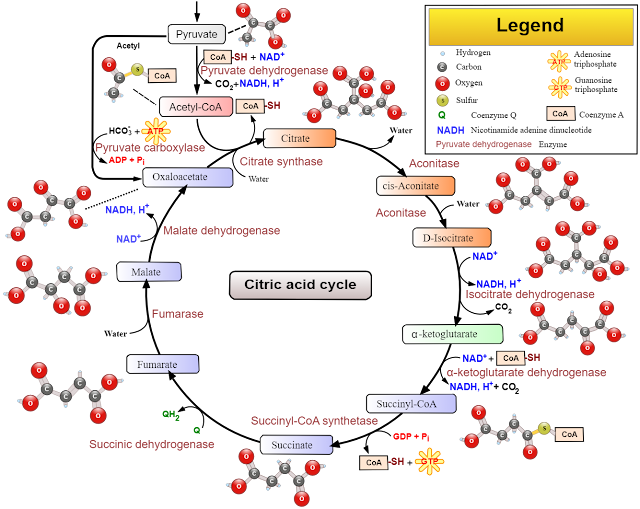Aerobic respiration:
Aerobic respiration is a process that cells use to release energy from food in the presence of oxygen. It is the most common type of respiration in animals and plants.
Aerobic respiration is a very efficient way to produce energy. It can produce up to 38 molecules of ATP from a single molecule of glucose. This is much more than can be produced by anaerobic respiration, which only produces 2 molecules of ATP from a single molecule of glucose.
Aerobic respiration is essential for the survival of most organisms. It provides the energy that cells need to carry out all of their functions, including growth, repair, and movement.
There are a few things that can interfere with aerobic respiration. One is a lack of oxygen. If there is not enough oxygen available, the cells will switch to anaerobic respiration, which is less efficient. Another thing that can interfere with aerobic respiration is a lack of nutrients. If the cells do not have enough glucose or other nutrients, they will not be able to produce enough ATP.
` The process of aerobic respiration can be divided into four stages:
Glycolysis:
Glycolysis is the first stage of aerobic respiration. It takes place in the cytoplasm of the cell and does not require oxygen. In glycolysis, a molecule of glucose is broken down into two molecules of pyruvate. This process releases two molecules of ATP, two molecules of NADH, and two molecules of water.
Krebs Cycle:
The Krebs cycle, also known as the citric acid cycle or the tricarboxylic acid cycle (TCA cycle), is a series of chemical reactions used by all aerobic organisms to release stored energy through the oxidation of acetyl-CoA derived from carbohydrates, fats, and proteins. The Krebs cycle is used by organisms that respire (as opposed to organisms that ferment) to generate energy, either by anaerobic respiration or aerobic respiration. In addition, the cycle provides precursors of certain amino acids, as well as the reducing agent NADH, that are used in numerous other reactions.
The Krebs cycle takes place in the mitochondria, the energy-producing organelles of cells. The cycle consists of eight steps, each of which is catalyzed by an enzyme. The first step in the cycle is the condensation of acetyl-CoA with oxaloacetate to form citrate. Citrate is then converted to isocitrate, which is oxidized to alpha-ketoglutarate. Alpha-ketoglutarate is then decarboxylated to succinyl-CoA, which is converted to succinate. Succinate is then oxidized to fumarate, which is hydrated to malate. Malate is then oxidized to oxaloacetate, which is ready to react with acetyl-CoA to begin the cycle again.
In each turn of the Krebs cycle, one molecule of acetyl-CoA is oxidized, two molecules of carbon dioxide are released, and three molecules of NADH and one molecule of FADH2 are produced. NADH and FADH2 are then used in the electron transport chain to generate ATP, the cell's main energy currency.
The Krebs cycle is a vital part of cellular respiration, and it plays a key role in the production of energy. The cycle also provides precursors for certain amino acids, and it helps to regulate the levels of certain hormones.
Here are the eight steps of the Krebs cycle:
1.Acetyl-CoA condenses with oxaloacetate to form citrate.
2.Citrate is isomerized to isocitrate.
3.Isocitrate is oxidized to alpha-ketoglutarate.
4.Alpha-ketoglutarate is decarboxylated to succinyl-CoA.
5.Succinyl-CoA is converted to succinate.
6.Succinate is oxidized to fumarate.
7.Fumarate is hydrated to malate.
8.Malate is oxidized to oxaloacetate, which is ready to react with acetyl-CoA to begin the cycle again.
 |
| Krebs cycle |
The Krebs cycle is a complex process, but it is essential for life. The cycle produces energy, provides precursors for certain amino acids, and helps to regulate the levels of certain hormones.
Here are some of the benefits of the Krebs cycle:
1.It produces energy. The Krebs cycle is a major source of energy for cells. The energy produced by the Krebs cycle is used to generate ATP, the cell's main energy currency.
2.It provides precursors for certain amino acids. The Krebs cycle provides precursors for certain amino acids, which are the building blocks of proteins.
3.It helps to regulate the levels of certain hormones. The Krebs cycle helps to regulate the levels of certain hormones, such as insulin and glucagon.
The Krebs cycle is a vital process that is essential for life. The cycle produces energy, provides precursors for certain amino acids, and helps to regulate the levels of certain hormones.
The Electron Transport Chain:
The electron transport chain is the third stage of aerobic respiration. It takes place in the inner membrane of the mitochondria and requires oxygen. In the electron transport chain, electrons are transferred from NADH and FADH2 to oxygen. This process releases a large amount of energy, which is used to pump protons across the inner membrane of the mitochondria.
Chemiosmostic phosphorylation:
Chemiosmotic phosphorylation is the fourth and final stage of aerobic respiration. It takes place in the inner membrane of the mitochondria and requires oxygen. In chemiosmosis, the protons that were pumped across the membrane in the electron transport chain flow back down their concentration gradient. This flow of protons generates ATP.

Comments
Post a Comment